
It is inevitable that any writer on this subject will search for ‘deaths related to jet ski accidents’ and it with sadness that I read that, only recently, a 22-year old male died in an accident with a PW, on the very afternoon of the day he bought it. The next story listed is that of a 22-year old female who tragically died in a collision with another rider. I will search no more and let us focus this article on the prevention of such tragedies and to encourage safe and responsible use of these powerful machines.
The rules and regulations for riding personal watercraft vary from country to country and it has been interesting to observe that the guidelines are becoming stricter year on year, with the introduction of helmets in some Mediterranean countries. Random checks are becoming more common, especially of PWs belonging to superyachts as unlicensed PWs or riders can be heavily fined.

It is generally agreed that the activity must only take place in daylight hours, but arguably this rule could be tightened when the sun doesn’t set until after 21:00hrs. The State of Florida bans operation of PW from 30 minutes after sunset through to 30 minutes before sunrise allowing for the variation in daylight hours. Greece is an example of a country that has limited the hours of use and close the activity down at 18:00hrs, in some areas of Italy, namely the Naples and Capri and Amalfi coast area, use is limited to the afternoons only, between 14:00hrs and 19:00hrs.
There are areas that are off limits for example marine reserves and national parks, and all countries stipulate distance from shore (Turkey, France, Greece and Malta are amongst the authorities that requires the activity to be a distance of at least 300m from the shore; the Balearic Islands seem happy with just 200m from shore whereas Italy insists on a minimum of 500m).
Speed limits are established between 3kn and 5kn in harbour areas and within the shoreline restrictions when returning to base. ‘Beaching’ the craft is subject to local laws and in many cases, a choice of the individual beach authority and indeed the rental or charter company. Most PW rental companies will state that beaching is not permitted and a security deposit will not be returned should the rider choose to ignore this.
Personal equipment is paramount with CE approved buoyancy aids as mandatory and a kill cord must be worn at all times. The issue of wearing a kill cord has been covered in The Islander many times, as throughout all maritime media and in the syllabus of all training organisations, yet accidents caused through failure to use the kill cord are still prevalent.
Items of personal equipment that are often overlooked is the clothing worn whilst riding. Water ingress when a rider falls of a PW at speed can cause life threatening injuries. A well-publicised story from the USA last year involves a 28-year old female who was in a coma for 2-weeks after falling from a PW at 50mph. The water propulsion entered her rectum, burst her colon and two major blood vessels leading to her blood turning septic. With major damage to all her internal organs, the young lady fought hard, and eight surgeries later, she is starting to rebuild her life. The way to help avoid such injuries to wear neoprene shorts or wetsuits to protect lower body openings from impact with the water.
The regulations are all well and good but one thing that can never be legislated for is individual responsibility and consideration of other water users. As the readers of The Islander are active water users, how often has your quiet lunch on anchor, a relaxing swim in the bay, or the calm of the water around your paddleboard been disrupted by an inconsiderate rider?
Consideration of other water users should surely be paramount? The idyllic coastlines of The Mediterranean are to be enjoyed by all yet we’ve all been inconvenienced by that one charter yacht that anchored close by with blaring music and shouting guests, or the RIB that came in to the anchorage just that little too fast so you and your friends have to hold on to plates and glasses whilst the turbulence calms down. Remember that time when you’d just drifted off into your siesta in the cockpit when a PW comes charging into the cala with that annoying ‘wasp of the sea’ noise?
There are restrictions as to how close a PW can be to other water users, some countries state 50m, some state 100m but may it be suggested that every rider of a PW considers the enjoyment of all and rides safely, and away, from those enjoying the quiet time on the water?
Personally, I’m a fan of the BVI’s rule where PWs are, quite simply, banned.
Enjoy the summer, stay safe, wear your kill cord and consider others.
Linda Revill
Photo credit: Sandra Mu/Getty Images














0 Comments